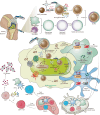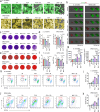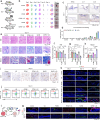Biodegradable oxygen-evolving metalloantibiotics for spatiotemporal sono-metalloimmunotherapy against orthopaedic biofilm infections
- PMID: 39277594
- PMCID: PMC11401848
- DOI: 10.1038/s41467-024-52489-x
Biodegradable oxygen-evolving metalloantibiotics for spatiotemporal sono-metalloimmunotherapy against orthopaedic biofilm infections
Abstract
Pathogen-host competition for manganese and intricate immunostimulatory pathways severely attenuates the efficacy of antibacterial immunotherapy against biofilm infections associated with orthopaedic implants. Herein, we introduce a spatiotemporal sono-metalloimmunotherapy (SMIT) strategy aimed at efficient biofilm ablation by custom design of ingenious biomimetic metal-organic framework (PCN-224)-coated MnO2-hydrangea nanoparticles (MnPM) as a metalloantibiotic. Upon reaching the acidic H2O2-enriched biofilm microenvironment, MnPM can convert abundant H2O2 into oxygen, which is conducive to significantly enhancing the efficacy of ultrasound (US)-triggered sonodynamic therapy (SDT), thereby exposing bacteria-associated antigens (BAAs). Moreover, MnPM disrupts bacterial homeostasis, further killing more bacteria. Then, the Mn ions released from the degraded MnO2 can recharge immune cells to enhance the cGAS-STING signaling pathway sensing of BAAs, further boosting the immune response and suppressing biofilm growth via biofilm-specific T cell responses. Following US withdrawal, the sustained oxygenation promotes the survival and migration of fibroblasts, stimulates the expression of angiogenic growth factors and angiogenesis, and neutralizes excessive inflammation. Our findings highlight that MnPM may act as an immune costimulatory metalloantibiotic to regulate the cGAS-STING signaling pathway, presenting a promising alternative to antibiotics for orthopaedic biofilm infection treatment and pro-tissue repair.
© 2024. The Author(s).
Conflict of interest statement
The authors declare the following competing interests: Z.S., C.Z., W.Z., D.X., and X.H. are inventors on a patent application (China Patent No. CN117018025A) based on the technology presented in this manuscript. The others authors declare no competing interests.
Figures









References
Publication types
MeSH terms
Substances
Associated data
- Actions
Grants and funding
LinkOut - more resources
Full Text Sources
Molecular Biology Databases
Research Materials

